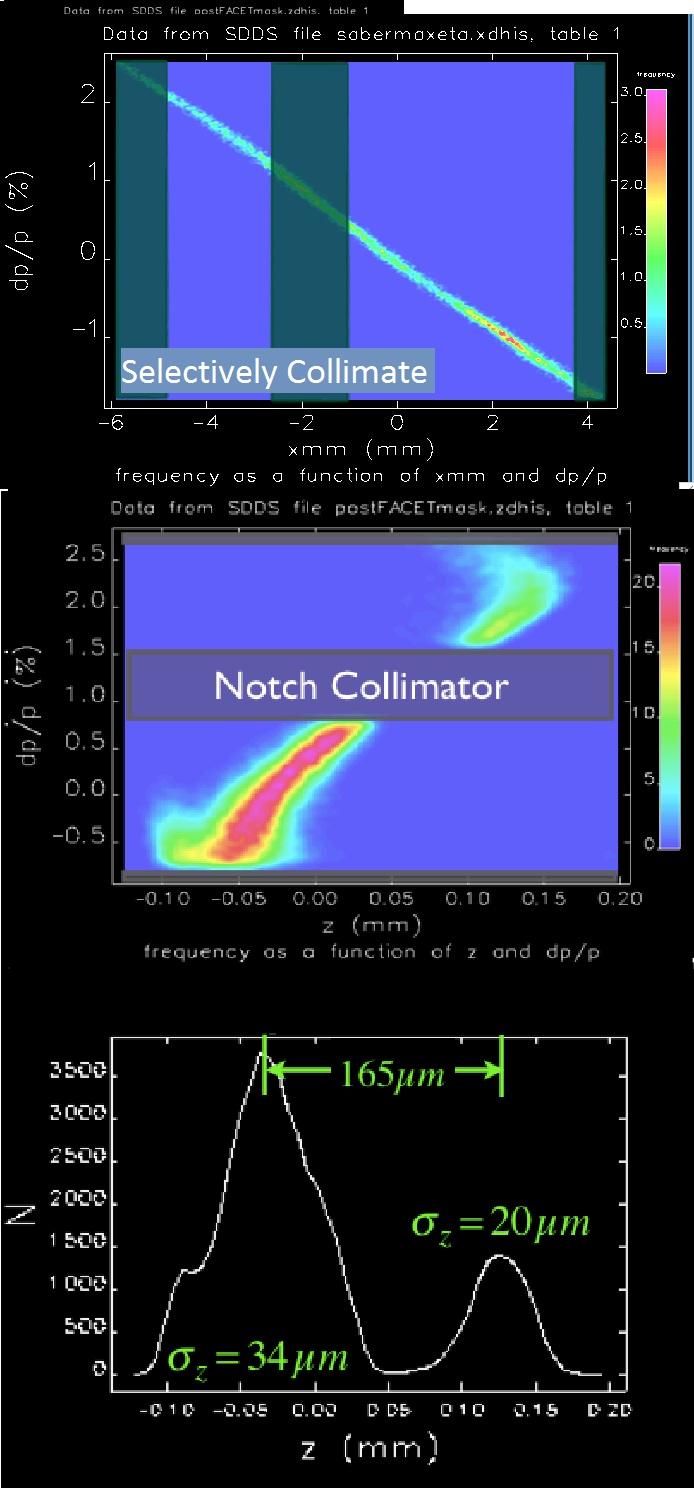Two-Bunch Production
Notch Collimator
FACET uses an instrument called a notch collimator, installed in the SLAC linac's Sector 20 bunch compressor, to split each of the linac's single electron bunches into two. The notch collimator takes advantage of the distribution of different energies of the incoming electrons to separate them into a leading "drive" bunch and following "witness" bunch. The drive bunch will knock electrons to the side as it passes through plasma inside the beam tube. The witness bunch will ride the electron wake created as the displaced plasma electrons spring back into place just behind it.
As they enter the notch collimator, the bunch of electrons—or later, positrons—necessarily has a distribution of energies that are highly correlated with position along the bunch. In the middle of the magnetic bunch compressor, the beam is dispersed in energy and in time. Thus, "collimating" a different portion of the bunch based on position will collimate a different portion of the bunch in time, and lead to different schemes for acceleration and bunch shapes. By placing a collimator of appropriate, variable geometry at different locations along the bunch, a wide variety of drive/witness bunch configurations can be created. One example that produces two bunches with a charge ratio, spacing and bunch length similar to that envisioned for a plasma wakefield linear collider is shown above. This technique can be used to generate an electron drive bunch with an electron witness bunch or a positron drive bunch along with a positron witness bunch.
Available to FACET Users is a simple GUI which shows the transverse and longitudinal phase space at a place of one's choosing in the FACET experimental area after tracking through from NRTL. This can be used to understand the theoretical capabilities of the notch and jaw collimators available for two-bunch production and shaping.

Sailboat Chicane

The notch collimator produces two bunches of electrons or two bunches of positrons. What about one positron and one electron bunch?
Currently, the linac can only deliver either electrons or positrons to FACET because the sector 20 bunch compressor only has one path and so can only be set up for one type of lepton.
However, the proposed sailboat chicane will take the existing Sector 20 chicane and add another path allowing both electrons and positrons to get through the final bunch compression.
A schematic view of the magnet layout is shown above. The lower chicane already exists in sector 20 (this is the third phase of the bunch compression). All initial experiments can be carried out with this single line. At a later date the upper chicane will be added to allow both electron and positron bunches to be placed one behind the other, to allow a drive bunch and witness bunch arrangement. The optics are arranged so that both bunches are compressed and focused the same way at the final focus point.
The scheme for both bunches entails a small-charged positron bunch accelerated ahead of a larger electron bunch in the linac. The electron bunch is sent through the lower chicane and the positrons through the upper chicane. Since the path lengths are carefully made to be different, the positron bunch comes out just behind the electron bunch at a position to be accelerated by the electron plasma wake fields. The distance of the positrons behind the electron bunch can be adjusted by slight adjustments of the length of the upper chicane.
